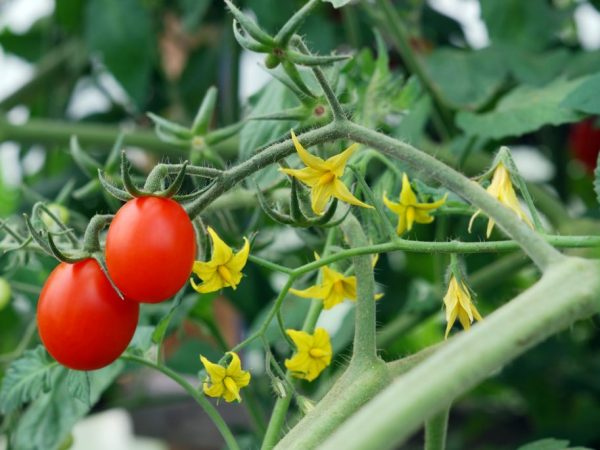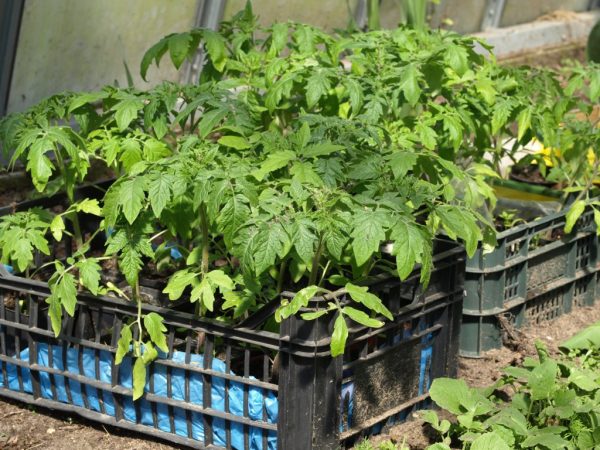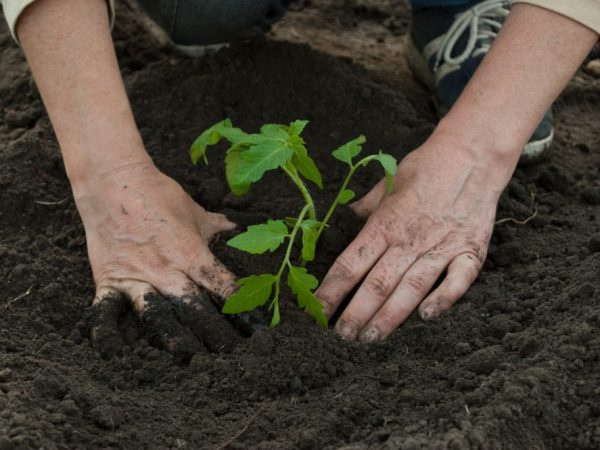Rules for processing tomatoes in the open field
The quantity and quality of the crop depends on the care of the tomatoes after planting in open ground. The processing of tomatoes must necessarily be carried out with means that ensure the correct development of the plant. Consider at what time and how it should be done.

Rules for processing tomatoes in the open field
Seed treatment before sowing
In order for the bush to feel good in the open field, pre-sowing processing of tomatoes should be carried out. This will protect them from pests and serious diseases.
When sowing seeds, it is necessary to carry out agrotechnical dressing. To do this, use the following methods:
- 1 tbsp. l. ash is added to a half-liter jar of water; the mixture is insisted for at least a day, after which it is filtered and the prepared seeds are soaked in it for about 5 hours;
- for 100 ml of warm water, take such an amount of potassium permanganate so that when diluted in water, a sufficiently dark color is obtained; all seeds are placed in the solution for no more than 15 minutes;
- no less effective method of dressing can be considered the one in which the seeds are soaked in Kalanchoe or aloe juice;
- if folk methods do not suit you, the seeds are treated with special germination stimulants.
After carrying out the listed procedures, they begin the process of breeding seedlings.
Tatiana Orlova (Candidate of Agricultural Sciences):
Among the methods of pre-sowing preparation, one of the most important for tomato as a heat-loving crop is seed hardening. Plants grown from hardened seeds will not become frost-resistant, but they tolerate prolonged cold snap better. Quenching is carried out with variable temperatures. When hardening, the seed is soaked until 1-2% of naklyuvshih seeds appear and kept at a low temperature close to 0 degrees for 10-12 hours. Then they are transferred to a warm room and kept at t 18-20 degrees for also 10-12 hours. Duration of hardening is 15-20 days.
Plant feeding
To process tomatoes, you can use both folk remedies and drugs purchased in specialized stores. Among the mandatory and necessary processing of tomatoes, three can be distinguished.
- The first feeding is about 10-15 days after the plant is planted in the ground.
- The second feeding is carried out during the flowering of the so-called second flower cluster.
- The third top dressing is at the stage of active fruiting of tomato bushes.
Frequency of top dressing
After 14 days, the first feeding is carried out. To prepare the product, take 10 liters of clean water, dilute 1 tbsp in it. l. nitrophosphate and 500 ml of mullein. About 1 liter of the prepared solution is poured under each tomato bush. In the absence of organic matter, mineral analogues are used. To do this, take 20 g of potassium sulfate and superphosphate for 10 liters of water. In this case, the expense from the use of such a drug will be exactly the same.
The second feeding will be effective when the plant is in bloom or after it. To prepare the drug, take 10 liters of water, in which 1 tbsp is diluted. l. potassium sulfate, 500 ml mullein or chicken droppings. About 1.5 liters of the prepared mixture are poured under each tomato bush. Also, to prepare the solution, mix 20 g of potassium sulfate and 15 g of ammonium nitrate. A similar drug is used no more than two times.
The third top dressing is final and is carried out when the tomato gives the first fruits. To prepare the preparation for feeding, take 10 liters of water, 1 tbsp. l. urea and 500 ml of chicken manure. About 1.5 liters of the prepared mixture are poured under each tomato bush.
Tatiana Orlova (Candidate of Agricultural Sciences):
The first feeding is carried out with nitrogen fertilizers, for example, ammonium nitrate or urea. Nitrogen is required for the growth of the venegative mass of plants. therefore, feeding with nitrogen or fast-acting organic fertilizer (infusion of mullein or chicken droppings) is carried out at the beginning of the growing season. When plants enter the flowering phase, the composition of the dressings changes, in addition to nitrogen, they must also contain phosphorus and potassium in equal proportions. The third feeding NEVER includes pure urea and chicken droppings. Top dressing also consists of complex fertilizers, but with a predominant share of phosphorus and potassium, little nitrogen is given. For example, the ratio of nutrients in the 3rd feeding N is 5%. P - 20% K - 20%.
Preventive measures

For the prevention of diseases, plants are watered with a manganese solution
To prevent plants from attacking pests and diseases, tomatoes must be processed. To do this, use an ordinary solution of potassium permanganate in a ratio of 1 g per 10 liters of water. The bushes are watered from a watering can. In this case, the soil should be impregnated with a solution about 20 cm deep. Precautionary spraying is carried out when the tomatoes are blooming.
Tatiana Orlova (Candidate of Agricultural Sciences):
Potassium permanganate is not a universal remedy. It can be used for seed dressing or soil disinfection after harvesting diseased crops. But for the prevention and treatment of diseases, as well as from pests, potassium permanganate will not help. Special preparations are used - fungicides or insecticides
We protect the culture from late blight
Due to early maturity, tomatoes are almost never affected by late blight. A similar disease is most often observed in tomatoes in July and August, so it is better to select early ripening varieties for planting.
To prevent the development of diseases, literally 5 days after planting tomatoes, top dressing is performed. In this case, the bushes are processed only in cloudy weather or late in the evening, so that the leaves of the plant do not receive a severe burn. During the vegetative period, such actions are carried out no more than 2-3 times. As for the choice of the means with which it is necessary to process tomatoes, preference is given to both folk remedies and those purchased in the store.
Tatiana Orlova (Candidate of Agricultural Sciences):
Preference should be given to really working drugs, not folk remedies. While gardeners will treat their diseased tomatoes with tinctures of ash or wormwood (or something else like that), it will take time. Late blight is a fungal disease. It develops under favorable conditions quickly like a forest fire. In a matter of days, all tomato plantings can turn black. The task of the vegetable grower is to prevent disease from appearing. For the purpose of prevention, tomato plantings are treated with Ridomil Gold preparations, copper-containing Abiga Peak, HOM, Bordeaux liquid.
Ideal tool
Ideal is one of the most demanded mineral and organic products. He:
- improves the survival rate of seedlings and their further germination;
- assists in the development of the root system;
- helps plants to quickly adapt to new conditions for them;
- improves flowering of crops and faster ripening of fruits;
- increases productivity indicators;
- actively combats many diseases (including late blight) and helps to get rid of pests;
- helps plants retain nutrients.
Both the root and non-root parts are treated with the drug. To prepare a top dressing for the root part, take about 8-10 ml of the drug diluted in 1 liter of water. The solution is used no more than 1 time in 10 days. To carry out foliar processing of tomatoes, about 4-5 ml of fertilizer is diluted in 1 liter of water. The plant is treated with a similar tool in dry weather.
Means Signor Tomato

Fertilizers can stimulate growth and fruiting
The tool is not inferior in efficiency to the previous one. Signor Tomato is a complex preparation of systemic contact action. Among the advantages of this fertilizer are called:
- an increase in the vegetative mass to the required level;
- reducing the likelihood of being affected by viral and fungal diseases;
- an increase in the indicators of drought resistance and heat resistance of the plant;
- improving productivity indicators;
- acceleration of fruit ripening.
To process tomatoes with this fertilizer, 30 ml of the preparation is diluted in 5 liters of pure water. This amount of solution will be enough to process 1 acre of land. Spraying is carried out when 15% of ripe fruits have already appeared on the bush.
Tatiana Orlova (Candidate of Agricultural Sciences):
Only insecticide or fungicide preparations are systemic or contact-intestinal. The former are embedded in the structure of the cell and remain in the organs and tissues of the plant for a relatively long time (2-3 weeks) and remain poisonous or simply inedible for insect pests or pathogens. Contact-intestinal causes the death of pathogens upon direct contact with them.
Other drugs
No less popular is the HOM agent, which is used to prevent fungal infections. Among the advantages of the drug are:
- excellent preventive effect;
- getting rid of a huge number of infections that can infect garden crops;
- the ability to combine with other drugs;
- low cost.
To treat the plant for prevention or treatment, the solution is prepared as follows: 30-40 g of the drug is diluted in a small amount of warm water, after which the volume is brought to about 10 liters. It is best to do this in the morning or late at night in the absence of strong winds. Spraying before and immediately after the rain will not be effective, so it is better to check the weather forecast in advance so that the tomato processing is not done in vain.



